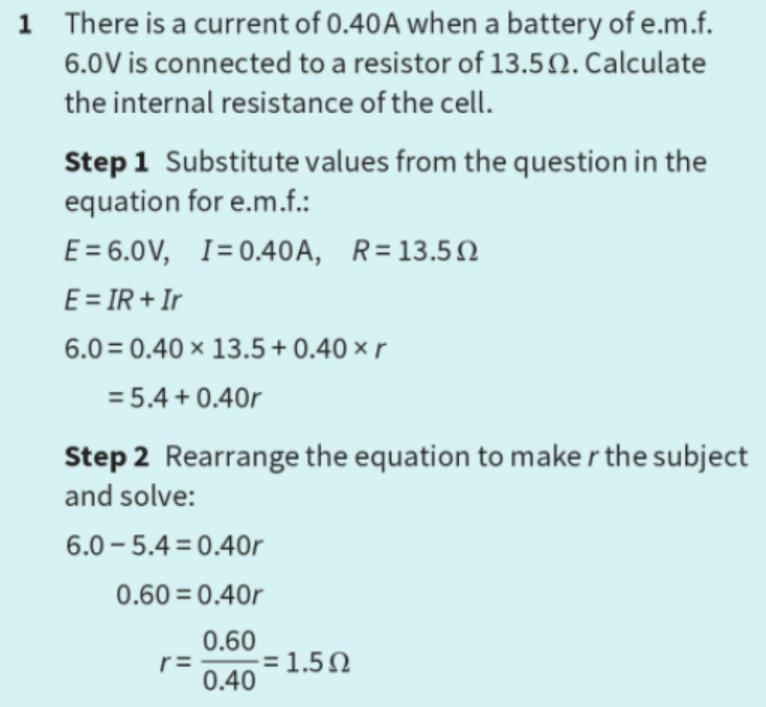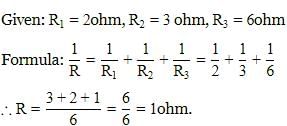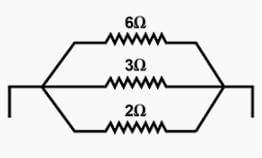All Exams >
JAMB >
Physics for JAMB >
All Questions
All questions of Current Electricity, Electrical Energy and Power for JAMB Exam
A car battery has ________ resistance than a dry cell.- a)same
- b)much lower
- c)slightly greater
- d)much higher
Correct answer is option 'B'. Can you explain this answer?
A car battery has ________ resistance than a dry cell.
a)
same
b)
much lower
c)
slightly greater
d)
much higher
|
|
Vijay Bansal answered |
Dry cell car batteries consist of a fiberglass mat that contains electrolytes. The electrolytes cause a chemical reaction that produces electricity. ... Although dry cell car batteries are expensive, they last longer than conventional wet cell batteries. They also have more power to crank the car's engine in bad weather.
The following fig. shows I-V graph for a given metallic wire at two temperatures T1and T2.Then,
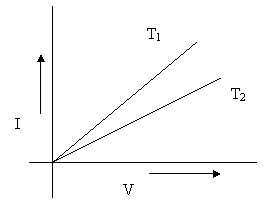
- a)Temperature T2 is less
- b)Temperature T2 is more
- c)T1 is same as T2
- d)None of the above
Correct answer is option 'B'. Can you explain this answer?
The following fig. shows I-V graph for a given metallic wire at two temperatures T1and T2.Then,
a)
Temperature T2 is less
b)
Temperature T2 is more
c)
T1 is same as T2
d)
None of the above

|
Knowledge Hub answered |
The slope of the graph = I / V
In case of T2, I/V is less. Hence, V/I (=R) is more.
Value of resistance increases with increasing temperature.
Hence, T2 >T
Five resistances are connected as shown in fig. The effective resistance between points A and B is
- a)20/30Ω
- b)15Ω
- c)10/3Ω
- d)6Ω
Correct answer is option 'C'. Can you explain this answer?
Five resistances are connected as shown in fig. The effective resistance between points A and B is
a)
20/30Ω
b)
15Ω
c)
10/3Ω
d)
6Ω

|
Lekshmi Basu answered |
The given circuit is a balanced Wheatstone bridge type, hence it can be simplified 

How many electrons are flowing per second through a section of a conductor corresponding to current of 1A?- a)7. 00 × 1018
- b)6.25 × 1018
- c)3.25 × 1016
- d)4.75 × 1017
Correct answer is 'B'. Can you explain this answer?
How many electrons are flowing per second through a section of a conductor corresponding to current of 1A?
a)
7. 00 × 1018
b)
6.25 × 1018
c)
3.25 × 1016
d)
4.75 × 1017

|
Vishal Giri answered |
I = q / t but we know q = n*e# where n = no. of electrons and e = charge on one electron. Let's put:: q=n*e we get I = n*e / t we know from given information that =============>I = 1A,,,,, t =1 s,,,, e = 1.602 * 10^ -19 C. put all these values in above equation we get 1 = n* 1.6 *10^ -19/ 1 hence n = 1 / 1.6*10^ -19 n = 0.625 * 10^ 19 n = 6.25 * 10^ 18IS THE UR ANSWER.
Under what condition, the current drawn from the cell is maximum?- a)R = r
- b)R > r
- c)R = 0
- d)R < r
Correct answer is option 'C'. Can you explain this answer?
Under what condition, the current drawn from the cell is maximum?
a)
R = r
b)
R > r
c)
R = 0
d)
R < r
|
|
Ritu Singh answered |
The maximum current can be drawn from a cell if the external resistance R = 0.
When current is to be drawn at max then the conducting wire rating comes high such that resistance is less.
Resistance R = rho x l/a
Rho = resistivity constant
L=length
a=area of cross-section
Hence, if the area of cross-section increases resistance decreases by increasing the rate of current to flow.
Specific resistance of a conductor increases with- a)Increase in cross-section and decrease in length
- b)Increase in cross-section
- c)Decrease in cross-section
- d)Increase in temperature
Correct answer is option 'D'. Can you explain this answer?
Specific resistance of a conductor increases with
a)
Increase in cross-section and decrease in length
b)
Increase in cross-section
c)
Decrease in cross-section
d)
Increase in temperature
|
|
Anjana Sharma answered |
Therefore resistance increases with the length. When cross sectional area increases the space of the elctrons to travel increases(simply explained). Therefore less amount of obstacles for the current. Therefore when area increases the resistance decreases.
If cells are joined in parallel, they have _______.- a)same current
- b)same emf
- c)same potential difference
- d)same internal resistance
Correct answer is option 'C'. Can you explain this answer?
If cells are joined in parallel, they have _______.
a)
same current
b)
same emf
c)
same potential difference
d)
same internal resistance
|
|
Hansa Sharma answered |
Components connected in parallel provide alternative pathways for current flow. When cells are connected in parallel, the total voltages that they provide does not change. For example, when two or more 2 V cells are connected in parallel, they still provide a total voltage of 2 V.
Three resistors of 4Ω, 12Ω , and 6Ω are connected in parallel. No. of 12Ω resistors required to be connected in parallel to reduce the total resistance to half of its original is- a)6
- b)3
- c)12
- d)2
Correct answer is 'A'. Can you explain this answer?
Three resistors of 4Ω, 12Ω , and 6Ω are connected in parallel. No. of 12Ω resistors required to be connected in parallel to reduce the total resistance to half of its original is
a)
6
b)
3
c)
12
d)
2
|
|
Riya Banerjee answered |
Here 4 Ω, 12 Ω, 6 Ω when connected in parallel results in 2Ω. to reduce it to half we have to join 1\R original = 6\12 for reducing it to half we have to join 6 , 12 Ω resistors in parallel (6\12) + (1\ 12 × 6) = 12\12 = 1 ohm . Half of its original value therefore option a is correct.
Two cells of 1.25 V and 0.75V are connected in parallel. The effective voltage will be- a)0.5 V
- b)2.00 V
- c)1.25 V
- d)0.75 V
Correct answer is option 'A'. Can you explain this answer?
Two cells of 1.25 V and 0.75V are connected in parallel. The effective voltage will be
a)
0.5 V
b)
2.00 V
c)
1.25 V
d)
0.75 V
|
|
Anjana Sharma answered |
When two cells are conneted in parallel , then
Effective Voltage,V = V1 − V2 = 1.25 − 0.75 = 0.5 V
What is the maximum current that can be drawn from a cell of emf E and internal resistance r connected to an external resistance R?- a)I = E/(R+r)
- b)infinite
- c)I = E/R
- d)I = E/r
Correct answer is option 'D'. Can you explain this answer?
What is the maximum current that can be drawn from a cell of emf E and internal resistance r connected to an external resistance R?
a)
I = E/(R+r)
b)
infinite
c)
I = E/R
d)
I = E/r
|
|
Preeti Iyer answered |
as the maximum current that can be drawn from a cell is for R =0 therefore, it is I = E/r.
1 ohm is equal to- a)1 volt per ampere
- b)1 ampere per millivolt
- c)1 milliampere per volt
- d)1 ampere per volt
Correct answer is option 'A'. Can you explain this answer?
1 ohm is equal to
a)
1 volt per ampere
b)
1 ampere per millivolt
c)
1 milliampere per volt
d)
1 ampere per volt
|
|
Anjana Sharma answered |
Reduced to base SI units, one ohm is the equivalent of one kilogram meter squared per second cubed per ampere squared (1 kg times m. s. A^-2 . The ohm is also the equivalent of a volt per ampere (V/A).
- a)1 ohm
- b)0.5 ohm
- c)1.5 ohm
- d)2 ohm
Correct answer is 'A'. Can you explain this answer?

|
Infinity Academy answered |
1st case[series]
I=E+E/r+r+1-----1
2nd case[parallel]
I=E[E will be same in parallel]/(1/r)+(1/r)+(1/1)----2
Current in both cases are the same.
1=2
2E/2r+1=E/(2/r)+1
R=1 Ω
I=E+E/r+r+1-----1
2nd case[parallel]
I=E[E will be same in parallel]/(1/r)+(1/r)+(1/1)----2
Current in both cases are the same.
1=2
2E/2r+1=E/(2/r)+1
R=1 Ω
If the potential difference V applied on a conductor is doubled, the drift velocity of electrons will become- a)vd
- b)2vd
- c)4vd
- d)

Correct answer is option 'B'. Can you explain this answer?
If the potential difference V applied on a conductor is doubled, the drift velocity of electrons will become
a)
vd
b)
2vd
c)
4vd
d)

|
EduRev JEE answered |
Drift velocity is directly proportional to potential difference.
Drift velocity is defined as the average velocity with which free electrons get drifted towards the positive end of the conductor under the influence of an external electric field.
Drift velocity is given by
vd= eEτ/ m
But, E=V/l
(if l is length of the conductor and V is constant potential difference applied across the ends of the conductor)
∴vd= eVτ/ml
⇒vd∝V
So, when the potential difference is doubled the drift velocity will be doubled.
Note - Current flowing through a conductor is directly proportional to the drift velocity.
Drift velocity is defined as the average velocity with which free electrons get drifted towards the positive end of the conductor under the influence of an external electric field.
Drift velocity is given by
vd= eEτ/ m
But, E=V/l
(if l is length of the conductor and V is constant potential difference applied across the ends of the conductor)
∴vd= eVτ/ml
⇒vd∝V
So, when the potential difference is doubled the drift velocity will be doubled.
Note - Current flowing through a conductor is directly proportional to the drift velocity.
At any junction, the sum of the currents entering the junction is equal to the sum of _______- a)potential around any closed loop
- b)voltages across the junction
- c)all the currents in the circuit
- d)currents leaving the junction
Correct answer is option 'D'. Can you explain this answer?
At any junction, the sum of the currents entering the junction is equal to the sum of _______
a)
potential around any closed loop
b)
voltages across the junction
c)
all the currents in the circuit
d)
currents leaving the junction

|
Om Kumar answered |
The correct answer is option 'D': currents leaving the junction.
Explanation:
At any junction in an electrical circuit, the sum of the currents entering the junction is equal to the sum of the currents leaving the junction. This is based on the principle of conservation of charge.
When current flows through a junction, it must split into multiple paths. The total amount of charge entering the junction must be equal to the total amount of charge leaving the junction. This is because charge cannot be created or destroyed, it can only flow through the circuit.
To better understand this concept, consider a simple circuit with three branches connected to a junction. Let's label the currents entering the junction as I1, I2, and I3, and the currents leaving the junction as I4, I5, and I6.
The principle of conservation of charge states that the total amount of charge entering the junction must be equal to the total amount of charge leaving the junction. Mathematically, this can be expressed as:
I1 + I2 + I3 = I4 + I5 + I6
This equation shows that the sum of the currents entering the junction (I1 + I2 + I3) is equal to the sum of the currents leaving the junction (I4 + I5 + I6).
This principle is a consequence of Kirchhoff's current law (KCL), which states that the algebraic sum of currents at any junction in an electrical circuit is zero. This means that the sum of currents entering the junction is equal to the sum of currents leaving the junction.
In summary, at any junction in an electrical circuit, the sum of the currents entering the junction is equal to the sum of the currents leaving the junction. This principle is based on the conservation of charge and is a consequence of Kirchhoff's current law.
Explanation:
At any junction in an electrical circuit, the sum of the currents entering the junction is equal to the sum of the currents leaving the junction. This is based on the principle of conservation of charge.
When current flows through a junction, it must split into multiple paths. The total amount of charge entering the junction must be equal to the total amount of charge leaving the junction. This is because charge cannot be created or destroyed, it can only flow through the circuit.
To better understand this concept, consider a simple circuit with three branches connected to a junction. Let's label the currents entering the junction as I1, I2, and I3, and the currents leaving the junction as I4, I5, and I6.
The principle of conservation of charge states that the total amount of charge entering the junction must be equal to the total amount of charge leaving the junction. Mathematically, this can be expressed as:
I1 + I2 + I3 = I4 + I5 + I6
This equation shows that the sum of the currents entering the junction (I1 + I2 + I3) is equal to the sum of the currents leaving the junction (I4 + I5 + I6).
This principle is a consequence of Kirchhoff's current law (KCL), which states that the algebraic sum of currents at any junction in an electrical circuit is zero. This means that the sum of currents entering the junction is equal to the sum of currents leaving the junction.
In summary, at any junction in an electrical circuit, the sum of the currents entering the junction is equal to the sum of the currents leaving the junction. This principle is based on the conservation of charge and is a consequence of Kirchhoff's current law.
Can you explain the answer of this question below:What is current I in the circuit as shown in figure?

- A:
1 A
- B:
2.0 A
- C:
1.2 A
- D:
0.5 A
The answer is b.
What is current I in the circuit as shown in figure?
1 A
2.0 A
1.2 A
0.5 A

|
Surya answered |
Yes option B is correct... first u straight the three resistance then it change in series... so u add three u get 6 ohms... after, that 6 ohm is parallel to 3ohm so;3/2.. so as per ohms law;V=IR (since:V=3; R=3/2; I=?) 3=3/2×I I=2ampere... that's it...hope u clear...!!👍😊
emf is measured in- a)J.C
- b)J
- c)J/C
- d)J/C/m
Correct answer is option 'C'. Can you explain this answer?
emf is measured in
a)
J.C
b)
J
c)
J/C
d)
J/C/m
|
|
Rohan Singh answered |
Electromotive force, abbreviated emf (denoted and measured in volts), is the electrical intensity or "pressure" developed by a source of electrical energy such as a battery or generator. ... This potential difference can drive an electric current if an external circuit is attached to the terminals. It is commonly measured in units of volts, equivalent in the metre–kilogram–second system to one joule per coulomb of electric charge. In the electrostatic units of the centimetre–gram–second system, the unit of electromotive force is the statvolt, or one erg per electrostatic unit of charge.
On heating a conductor its resistance- a)depends on type of metal
- b)remains constant
- c)increases
- d)decreases
Correct answer is option 'C'. Can you explain this answer?
On heating a conductor its resistance
a)
depends on type of metal
b)
remains constant
c)
increases
d)
decreases
|
|
Rahul Bansal answered |
The resistance increases as the temperature of a metallic conductor increase, so the resistance is directly proportional to the temperature. When we increase the temperature the amplitude of vibration of atoms increases as a result of which the number of collision among the electrons and atom increases, and hence resistances increases.
- a)yes
- b)No
- c)Can’t predict
- d)None of the above
Correct answer is 'A'. Can you explain this answer?

|
Vaishnavi Nayak answered |
In series connection of cells total internal resistance=nr total resistance of circuit=nR current is same potential difference is different so,I=nv/nR+nr I=V/R+r current is same as before in parallel connection of cells total internal resistance=r/n total resistance of circuit=R/n total current=nI potential difference is same nI=V/r/n+R/n I=V/R+r current is same as before
- a)0.75 A
- b)1.05 A
- c)2 A
- d)3 A
Correct answer is 'A'. Can you explain this answer?
|
|
Rohan Singh answered |
Total inner voltage E = 2*3 = 6.0 V
Total resist. Rt = 0.2*3*7.4 = 8.0 ohm
circulating current I = E/Rt = 6/8 = 3/4 = 0.75 A
- a)0.11 ohm
- b)0 ohm
- c)0. 12 ohm
- d)1.1 ohm
Correct answer is 'B'. Can you explain this answer?
|
|
Rajeev Saxena answered |
Total emf = 3 x 4 = 12 V
Total resistance = 6 + 3r
Current in the circuit = 2 A
Using ohms law
2 = 12/ (6+3r)
2(6+3r)=12
12+6r=12
6r = 12-12 = 0
r = 0/6 = 0
A carbon resistor is marked in green, red, and orange bands. The approximate resistance of the resistor is
- a)52 x 103 Ω
- b)25000 Ω
- c)5 x 102 Ω
- d)5 x 104 Ω
Correct answer is option 'A'. Can you explain this answer?
A carbon resistor is marked in green, red, and orange bands. The approximate resistance of the resistor is
a)
52 x 103 Ω
b)
25000 Ω
c)
5 x 102 Ω
d)
5 x 104 Ω
|
|
Anjana Sharma answered |
To determine the resistance of a carbon resistor based on the color bands, we need to refer to the standard resistor color code. The colors represent digits and multipliers as follows:
- Green: 5
- Red: 2
- Orange: Multiplier of 10^3 (1,000)
Given the color bands: Green, Red, Orange
The resistance value is calculated as follows:
- First digit: Green = 5
- Second digit: Red = 2
- Multiplier: Orange = 10^3 (1,000)
So the resistance is:
Resistance=(52)×10^3 ohms=52,000 ohms=52 kilo-ohms
Answer: The approximate resistance of the resistor is 52 kΩ.
The Wheatstone bridge Principle is deduced using- a)Gauss’s Law
- b)Kirchhoff’s Laws
- c)Coulomb’s Law
- d)Newton’s Laws
Correct answer is option 'B'. Can you explain this answer?
The Wheatstone bridge Principle is deduced using
a)
Gauss’s Law
b)
Kirchhoff’s Laws
c)
Coulomb’s Law
d)
Newton’s Laws
|
|
Anjana Sharma answered |
PRINCIPLE: Wheatstone bridge principle states that when the bridge is balanced, the product of the resistance of the opposite arms are equal. The files that I had attached in which I had derived Wheatstone bridge equation using Kirchhoff law is useful to you.
Can you explain the answer of this question below:The ______ of changes in potential around any closed loop involving resistors and cells in a loop is zero.- A:product
- B:algebraic sum
- C:difference
- D:sum of absolute values
The answer is b.
The ______ of changes in potential around any closed loop involving resistors and cells in a loop is zero.
A:
product
B:
algebraic sum
C:
difference
D:
sum of absolute values
|
|
Lavanya Menon answered |
In accordance with Kirchhoff’s second law i.e. Kirchhoff’s voltage law (KVL), the algebraic sum of all the potential differences in a closed electric circuit or closed loop that contains one or more cells and resistors is always equal to zero.
This law is popularly called the law of conservation of voltage.
This law is popularly called the law of conservation of voltage.
In a meter bridge experiment a balance point is obtained at a distance of 60 cm from the left end when unknown resistance R is in a left gap and 8 ohms resistor is connected in the right gap. When the position of R and 8 ohm resistor is interchanged the balance point will be at distance of- a)40 cm
- b)30 cm
- c)50 cm
- d)60 cm
Correct answer is option 'A'. Can you explain this answer?
In a meter bridge experiment a balance point is obtained at a distance of 60 cm from the left end when unknown resistance R is in a left gap and 8 ohms resistor is connected in the right gap. When the position of R and 8 ohm resistor is interchanged the balance point will be at distance of
a)
40 cm
b)
30 cm
c)
50 cm
d)
60 cm
|
|
Jyoti Sengupta answered |
60/40 = l/100-l, = R/8
so R=12
now changed position 8 is proportional to l and 12 to (100-l)
8/12 = l/100-l
l = 40ohm
The equivalent emf of two cells (with ε1 > ε2) in series if we connect two negative electrodes of adjacent cells is- a)εequivalent =

- b)εequivalent =

- c)εequivalent = ε2 - ε1 (ε1 > ε2)
- d)εequivalent = ε1 - ε2 (ε1 > ε2)
Correct answer is option 'D'. Can you explain this answer?
The equivalent emf of two cells (with ε1 > ε2) in series if we connect two negative electrodes of adjacent cells is
a)
εequivalent = 
b)
εequivalent = 
c)
εequivalent = ε2 - ε1 (ε1 > ε2)
d)
εequivalent = ε1 - ε2 (ε1 > ε2)

|
Sushil Kumar answered |
When we connect cells to form a battery, we join opposite ends(+ve with -ve and vice versa) to get supporting emf, i.e. net emf get added, but when we join the same polarities(-ve with -ve, like in the question), they oppose each other, hence net emf is the difference b/w them.
The expression for equivalent emf when two cells of emf’s
εeq = ε1 - ε2 (ε1> ε2)
The expression for equivalent emf when two cells of emf’s
εeq = ε1 - ε2 (ε1> ε2)
Current provided by a battery is maximum when- a)internal resistance is equal to external resistance
- b)internal resistance is greater then external resistance
- c)internal resistance is less than external resistance
- d)none of these
Correct answer is option 'A'. Can you explain this answer?
Current provided by a battery is maximum when
a)
internal resistance is equal to external resistance
b)
internal resistance is greater then external resistance
c)
internal resistance is less than external resistance
d)
none of these
|
|
Pooja Mehta answered |
Current provided by a battery is maximum when internal resistance is equal to external resistance. As a battery discharges, not only does it diminish its internal store of energy, but its internal resistance also increases (as the electrolyte becomes less and less conductive), and its open-circuit cell voltage decreases (as the chemicals become more and more dilute). The most deceptive change that a discharging battery exhibits is increased resistance.
Manganin and constantan have a low temperature coefficient of resistivity which means that- a)their resistance values change very little with temperature
- b)their resistance values only change at low temperatures
- c)their resistance values change greatly with temperature
- d)their resistance values do not change with temperature
Correct answer is option 'A'. Can you explain this answer?
Manganin and constantan have a low temperature coefficient of resistivity which means that
a)
their resistance values change very little with temperature
b)
their resistance values only change at low temperatures
c)
their resistance values change greatly with temperature
d)
their resistance values do not change with temperature
|
|
Rajat Kapoor answered |
The semiconductors and insulating material are having negative temperature coefficient of resistance. Therefore, the resistance of semiconductors and insulators decrease with rise in temperature. Alloys, such as manganin, constantan etc. are having very low and positive temperature coefficient of resistance.
Two special characteristics of the element of an electric heater:- a)low resistivity and high melting point
- b)low resistivity and low melting point
- c)high resistivity and low melting point
- d)high resistivity and high melting point
Correct answer is option 'D'. Can you explain this answer?
Two special characteristics of the element of an electric heater:
a)
low resistivity and high melting point
b)
low resistivity and low melting point
c)
high resistivity and low melting point
d)
high resistivity and high melting point

|
Samiksha Narwade answered |
Electric heater is device to heat water.... So when it have high melting pt. it we sustain heat nd won't melt....nd resistance means to oppose heat... So it should have high resistivity to heat water without getting damage....HOPE THIS WILL HELP YOU....!
The dimension of the temperature coefficient of resistivity is- a)(temperature.ohm)-1
- b)same as temperature.ohm
- c)same as (temperature)-1
- d)same as (temperature)2
Correct answer is option 'C'. Can you explain this answer?
The dimension of the temperature coefficient of resistivity is
a)
(temperature.ohm)-1
b)
same as temperature.ohm
c)
same as (temperature)-1
d)
same as (temperature)2
|
|
Ameya Pillai answered |
Temperature Coefficient of Resistivity
The temperature coefficient of resistivity is defined as the change in the electrical resistance of a material per unit change in temperature. It is denoted by the symbol α and has units of inverse temperature (K^-1) or reciprocal temperature (1/T).
Effect of Temperature on Electrical Resistance
When the temperature of a conductor increases, its electrical resistance also increases. This is due to the fact that as the temperature increases, the atoms in the conductor vibrate more vigorously, which results in more collisions between the electrons and the atoms. This increase in collisions leads to an increase in the resistance of the conductor.
Formula for Temperature Coefficient of Resistivity
The temperature coefficient of resistivity is given by the formula:
α = (1/ρ) x (dρ/dT)
where ρ is the resistivity of the material and dρ/dT is the rate of change of the resistivity with temperature.
Dimension of Temperature Coefficient of Resistivity
The dimension of the temperature coefficient of resistivity is the same as that of reciprocal temperature or (temperature)^-1. This can be seen from the formula for the temperature coefficient of resistivity:
α = (1/ρ) x (dρ/dT)
where ρ has units of ohm-meters (Ω.m) and dρ/dT has units of ohm-meters per Kelvin (Ω.m/K). Thus, the units of α are K^-1 or 1/T.
Conclusion
In conclusion, the temperature coefficient of resistivity is a measure of how the electrical resistance of a material changes with temperature. It has units of inverse temperature or reciprocal temperature, and its dimension is the same as that of (temperature)^-1.
The temperature coefficient of resistivity is defined as the change in the electrical resistance of a material per unit change in temperature. It is denoted by the symbol α and has units of inverse temperature (K^-1) or reciprocal temperature (1/T).
Effect of Temperature on Electrical Resistance
When the temperature of a conductor increases, its electrical resistance also increases. This is due to the fact that as the temperature increases, the atoms in the conductor vibrate more vigorously, which results in more collisions between the electrons and the atoms. This increase in collisions leads to an increase in the resistance of the conductor.
Formula for Temperature Coefficient of Resistivity
The temperature coefficient of resistivity is given by the formula:
α = (1/ρ) x (dρ/dT)
where ρ is the resistivity of the material and dρ/dT is the rate of change of the resistivity with temperature.
Dimension of Temperature Coefficient of Resistivity
The dimension of the temperature coefficient of resistivity is the same as that of reciprocal temperature or (temperature)^-1. This can be seen from the formula for the temperature coefficient of resistivity:
α = (1/ρ) x (dρ/dT)
where ρ has units of ohm-meters (Ω.m) and dρ/dT has units of ohm-meters per Kelvin (Ω.m/K). Thus, the units of α are K^-1 or 1/T.
Conclusion
In conclusion, the temperature coefficient of resistivity is a measure of how the electrical resistance of a material changes with temperature. It has units of inverse temperature or reciprocal temperature, and its dimension is the same as that of (temperature)^-1.
The internal resistance of a battery cannot be measured with a conventional multimeter- a)since the resistance has a small value
- b)since it is not a measurable quantity
- c)since it requires a current to be observed
- d)since it is a fictitious quantity
Correct answer is option 'C'. Can you explain this answer?
The internal resistance of a battery cannot be measured with a conventional multimeter
a)
since the resistance has a small value
b)
since it is not a measurable quantity
c)
since it requires a current to be observed
d)
since it is a fictitious quantity

|
Manish Aggarwal answered |
The correct option is C
since it requires a current to be observed
It can be calculated from current and voltage data measured from a test circuit containing the battery and a load resistor
What is current I in the circuit as shown in figure?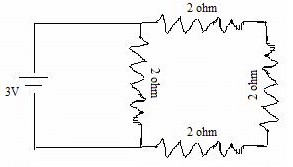
- a)1 A
- b)2.0 A
- c)1.2 A
- d)0.5 A
Correct answer is option 'B'. Can you explain this answer?
What is current I in the circuit as shown in figure?
a)
1 A
b)
2.0 A
c)
1.2 A
d)
0.5 A
|
|
Preeti Iyer answered |
Three 2Ω resistors are in series. Their total resistance =6Ω. Now it is in parallel with 2Ω resistor, so total resistance,
1/R=1/2+1/6=3+1/6=4/6=2/3
R=3/2
∴I=RV=3/(3/2)=3×2/3=2A
1/R=1/2+1/6=3+1/6=4/6=2/3
R=3/2
∴I=RV=3/(3/2)=3×2/3=2A
The following fig. shows I-V graph for a given metallic wire at two temperatures T1and T2.Then,
- a)Temperature T2 is less
- b)Temperature T2 is more
- c)T1 is same as T2
- d)None of the above
Correct answer is option 'C'. Can you explain this answer?
The following fig. shows I-V graph for a given metallic wire at two temperatures T1and T2.Then,
a)
Temperature T2 is less
b)
Temperature T2 is more
c)
T1 is same as T2
d)
None of the above
|
|
Rahul Bansal answered |
The slope of the given graph gives us the inverse of resistance. Resistance of a material increases with increasing temperature because the collision between the molecules increases.
In the graph given, T2 has a smaller slope and hence corresponds to higher resistance. Therefore, T2 > T1.
When number of identical cells, in parallel combination are increased, the voltage of the circuit will- a)Increase
- b)Decrease
- c)Remain same
- d)Depends on the internal resistance of the battery
Correct answer is option 'C'. Can you explain this answer?
When number of identical cells, in parallel combination are increased, the voltage of the circuit will
a)
Increase
b)
Decrease
c)
Remain same
d)
Depends on the internal resistance of the battery
|
|
Lavanya Menon answered |
The voltage developed by the cells in parallel connection cannot be increased by increasing the number of cells present in the circuit. It is because they do not have the same circular path. In parallel connection the connection provides power based on one cell.
The voltage will remain the same.
The voltage will remain the same.
Resistors can be wire bound or carbon resistors. Wire bound resistors are generally made of- a)Aluminium
- b)Carbon
- c)Copper
- d)Manganin
Correct answer is option 'D'. Can you explain this answer?
Resistors can be wire bound or carbon resistors. Wire bound resistors are generally made of
a)
Aluminium
b)
Carbon
c)
Copper
d)
Manganin
|
|
Anjana Sharma answered |
The wire material has a high resistivity, and is usually made of an alloy such as Nickel-chromium (Nichrome) or a copper-nickel-manganese alloy called Manganin. Common core materials include ceramic, plastic and glass. Wire wound resistors are the oldest type of resistors that are still manufactured today.
A steady current flows in a metallic conductor of non-uniform cross-section. The quantity/quantities constant along the length of the conductor is/are- a)Current and drift speed
- b)Current, electric field and drift velocity
- c)Speed only
- d)Current only.
Correct answer is option 'D'. Can you explain this answer?
A steady current flows in a metallic conductor of non-uniform cross-section. The quantity/quantities constant along the length of the conductor is/are
a)
Current and drift speed
b)
Current, electric field and drift velocity
c)
Speed only
d)
Current only.
|
|
Rahul Bansal answered |
Steady current implies current is uniform across the cross-section.
Since current is constant, current per unit area and hence drift velocity are not constant.
J = nevd = σE
The above relation shows that nothing apart from the current is constant.
- a)2.5 ohm
- b)3.2 ohm
- c)2 ohm
- d)4.5 ohm
Correct answer is 'A'. Can you explain this answer?

|
Infinity Academy answered |
The internal resistance of the cell can be obtained from the relation,
I=ε/R+r
0.2=2.5/(10+r)=2.5ohm
I=ε/R+r
0.2=2.5/(10+r)=2.5ohm
The type of materials whose resistivity is affected on adding the impurity is known as- a)Semiconductor
- b)Insulator
- c)Iron alloys
- d)Conductor
Correct answer is option 'A'. Can you explain this answer?
The type of materials whose resistivity is affected on adding the impurity is known as
a)
Semiconductor
b)
Insulator
c)
Iron alloys
d)
Conductor
|
|
Vijay Bansal answered |
Semiconductor - A material that is neither a good conductor of electricity nor a good insulator, but has properties of electrical conductivity somewhere between the two. Silicon and germanium are good semiconductor materials.
The voltage V and current. I graphs for a conductor at two different temperatures T1 and T2 are shown in the figure.
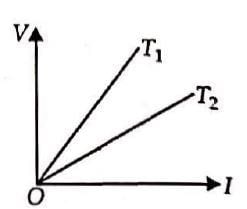
The relation between T1 and T2 is- a)T1 > T2
- b)T1 < T2
- c)T1 = T2
- d)T1 = 1/T2
Correct answer is option 'A'. Can you explain this answer?
The voltage V and current. I graphs for a conductor at two different temperatures T1 and T2 are shown in the figure.

The relation between T1 and T2 is

The relation between T1 and T2 is
a)
T1 > T2
b)
T1 < T2
c)
T1 = T2
d)
T1 = 1/T2
|
|
Riya Banerjee answered |
The slope of V-I graph gives the resistance of a conductor at a given temperature.
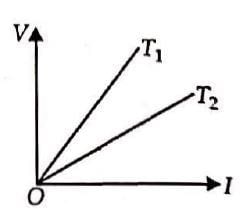
From the graph, it follows that resistance of a conductor at temperature T1 is greater than at temperature T2. As the resistance of a conductor is more at higher temperature and less at lower temperature.
Hence T1 >T2.

From the graph, it follows that resistance of a conductor at temperature T1 is greater than at temperature T2. As the resistance of a conductor is more at higher temperature and less at lower temperature.
Hence T1 >T2.
If cells are joined in series, they have ________.- a)same internal resistance
- b)same potential difference
- c)same emf
- d)same current
Correct answer is option 'D'. Can you explain this answer?
If cells are joined in series, they have ________.
a)
same internal resistance
b)
same potential difference
c)
same emf
d)
same current

|
.mie. answered |
In series circuit, the same current is flowing through each resistor...
but the voltage across each resistor varies...
because higher the value of resistance in resistor..
greater is the voltage drop acrosss that resistor....
Meter Bridge is used to- a)determine unknown voltage v
- b)determine unknown resistance R
- c)determine unknown power P
- d)determine unknown emf e
Correct answer is option 'B'. Can you explain this answer?
Meter Bridge is used to
a)
determine unknown voltage v
b)
determine unknown resistance R
c)
determine unknown power P
d)
determine unknown emf e

|
Maulik Mehra answered |
Explanation:With a known resistance in one of the gaps, the meter bridge is used to determine the value of unknown resistance by the formula.
Three resistors of 4Ω, 12Ω , and 6Ω are connected in parallel. No. of 12Ω resistors required to be connected in parallel to reduce the total resistance to half of its original is- a)6
- b)3
- c)12
- d)2
Correct answer is 'A'. Can you explain this answer?
Three resistors of 4Ω, 12Ω , and 6Ω are connected in parallel. No. of 12Ω resistors required to be connected in parallel to reduce the total resistance to half of its original is
a)
6
b)
3
c)
12
d)
2

|
Seblewongel Girma answered |
RT1=R4R12R6÷(R4+R12+R6)
RT2=R4R12R6÷(nR4+R12+R6)
RT1=4×12×6÷(4+12+6)=144/11. ,RT2=1/2RT1
1/2RT1=4×12×6÷(n4+12+6)
1/2×(144÷11)=288÷(4n+18)
9+2n=22
2n=13. n=6.5 ~n=6
RT2=R4R12R6÷(nR4+R12+R6)
RT1=4×12×6÷(4+12+6)=144/11. ,RT2=1/2RT1
1/2RT1=4×12×6÷(n4+12+6)
1/2×(144÷11)=288÷(4n+18)
9+2n=22
2n=13. n=6.5 ~n=6
The Wheatstone bridge is balanced for four resistors R1,R2,R3 and R4 with a cell of emf 1.46 V. The cell is now replaced by another cell of emf 1.08 V. To obtain the balance again
- a)All the four resistance should be changed
- b)Both the resistance R1 and R4 should be changed
- c)No resistance needs to be changed
- d)Resistance R4 should be changed only
Correct answer is option 'C'. Can you explain this answer?
The Wheatstone bridge is balanced for four resistors R1,R2,R3 and R4 with a cell of emf 1.46 V. The cell is now replaced by another cell of emf 1.08 V. To obtain the balance again
a)
All the four resistance should be changed
b)
Both the resistance R1 and R4 should be changed
c)
No resistance needs to be changed
d)
Resistance R4 should be changed only
|
|
Neha Sharma answered |
The balance point of the Wheatstone’s bridge is determined by the ratio of the resistances. The change in the emf of the external battery will have no effect on the balance point.
Explanation:
- Initial Balanced Wheatstone Bridge: In the initial balanced Wheatstone bridge configuration, the emf of the cell is 1.46 V and all four resistors R1, R2, R3, and R4 are set to specific values to achieve balance.
- Replacement of Cell: When the cell is replaced by another cell with an emf of 1.08 V, the balance of the Wheatstone bridge is disrupted.
- Requirement for Rebalancing: In order to rebalance the Wheatstone bridge with the new cell of emf 1.08 V, no resistance needs to be changed.
- Reasoning: The balance of the Wheatstone bridge is determined by the ratio of the resistances in the bridge arms and not by the absolute values of the resistances. As long as the ratio of the resistances remains the same, the balance will be maintained regardless of the emf of the cell.
- Conclusion: Therefore, in this scenario, no resistance needs to be changed to obtain the balance again with the new cell of emf 1.08 V.
Chapter doubts & questions for Current Electricity, Electrical Energy and Power - Physics for JAMB 2025 is part of JAMB exam preparation. The chapters have been prepared according to the JAMB exam syllabus. The Chapter doubts & questions, notes, tests & MCQs are made for JAMB 2025 Exam. Find important definitions, questions, notes, meanings, examples, exercises, MCQs and online tests here.
Chapter doubts & questions of Current Electricity, Electrical Energy and Power - Physics for JAMB in English & Hindi are available as part of JAMB exam.
Download more important topics, notes, lectures and mock test series for JAMB Exam by signing up for free.
Physics for JAMB
260 videos|277 docs|238 tests
|


